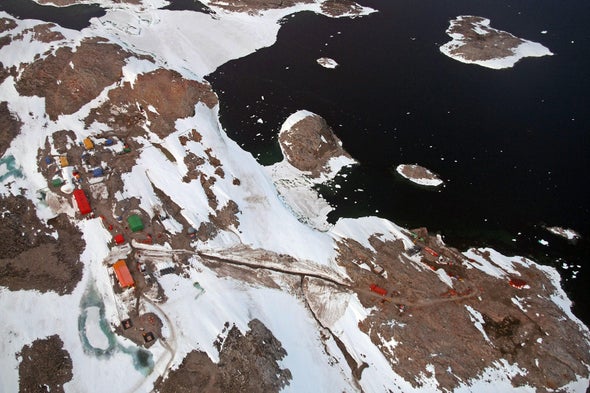Historical bad practices have left a legacy of pollution in the fragile ecosystem of Antarctica, but efforts are underway to chart a better future
Antarctica is often described as one of the most pristine places in the world, but it has a dirty secret. Parts of the sea floor near Australia’s Casey research station are as polluted as the harbour in Rio de Janeiro, Brazil, according to a study published in PLOS One in August.
The contamination is likely to be widespread across Antarctica’s older research stations, says study co-author Jonathan Stark, a marine ecologist at the Australian Antarctic Division in Hobart. “These contaminants accumulate over long time frames and don’t just go away,” he says.
Stark and his colleagues found high concentrations of hydrocarbons — compounds found in fuels — and heavy metals, such as lead, copper and zinc. Many of the samples were also loaded with polychlorinated biphenyls, highly carcinogenic chemical compounds that were common before their international ban in 2001.
When the researchers compared some of the samples with data from the World Harbour Project — an international collaboration that tracks large urban waterways — they found that lead, copper and zinc levels in some cases were similar to those seen in parts of Sydney Harbour and Rio de Janeiro over the past two decades.
WIDESPREAD POLLUTION
The problem of pollution is not unique to Casey station, says Ceisha Poirot, manager of policy, environment and safety at Antarctica New Zealand in Christchurch. “All national programmes are dealing with this issue,” she says. At New Zealand’s Scott Base — which is being redeveloped — contamination left from past fuel spills and poor waste management has been detected in soil and marine sediments. More of this historical pollution will emerge as the climate warms, says Poirot. “Things that were once frozen in the soil are now becoming more mobile,” she says.
Most of Antarctica’s contamination is due to historically poor waste management. In the old days, waste was often just dumped a small distance from research stations, says Terence Palmer, a marine scientist at Texas A&M University–Corpus Christi.
Research stations started to get serious about cleaning up their act in 1991. In that year, an international agreement known as the Protocol on Environmental Protection to the Antarctic Treaty, or the Madrid Protocol, was adopted. This designated Antarctica as a “natural reserve, devoted to peace and science” and directed nations to monitor environmental impacts related to their activities. But much of the damage had already been done — roughly two-thirds of Antarctic research stations were built before 1991.
And although historical pollution is a problem, future pollution remains a concern as the icy continent becomes more crowded. There are already more than 100 research stations or national facilities, and most of the buildings are located in ice-free areas, where they jostle with wildlife for a foothold on the most viable land. Ice-free areas make up less than 1% of Antarctica, but they support the highest diversity of plants and animals, including penguin and seal colonies.
A 2019 study found that more than half of all ice-free areas on the coastline have ground disturbance that’s visible from space. “The stations have quite a large footprint for the number of people that are there,” says Shaun Brooks, a conservation scientist at the Commonwealth Scientific and Industrial Research Organisation (CSIRO) in Hobart who co-authored the study.
Each nation is responsible for its own environmental monitoring around research stations, and practices vary, says Brooks. He and his colleagues have proposed a solution in a preprint posted on the Social Science Research Network last month. They outline a nine-step process to help station managers set objectives for reducing the impact of their facilities on nearby ecosystems.
Other researchers are working on ways to reverse the damage of past practices. Lucas Martínez Álvarez, who specializes in bioremediation at the Argentine Antarctic Institute in Buenos Aires, and his colleagues are using bacteria to remove hydrocarbons from soil around Argentina’s Carlini Base on King George Island. In 2020, Martínez Álvarez and his team reported that they were able to remove more than 75% of hydrocarbons from fuel-contaminated soil. The approach could reduce the need to ship tonnes of contaminated soil out of Antarctica, says Martínez Álvarez.
Stark says that the Australian Antarctic Division has already begun upgrading wastewater treatment facilities at its Casey and Davis stations. The next step for Stark and his colleagues is to assess whether historical pollution continues to affect Antarctic ecosystems today. Stark’s earlier studies have shown that polluted areas in Antarctica are less biodiverse than control locations, with some resilient species becoming more dominant. “It will be interesting to see if these effects have persisted — or gotten worse — or if communities have adapted in any way,” says Stark.
This article is reproduced with permission and was first published on September 1, 2023.



Recommended Comments
There are no comments to display.
Join the conversation
You can post now and register later. If you have an account, sign in now to post with your account.
Note: Your post will require moderator approval before it will be visible.